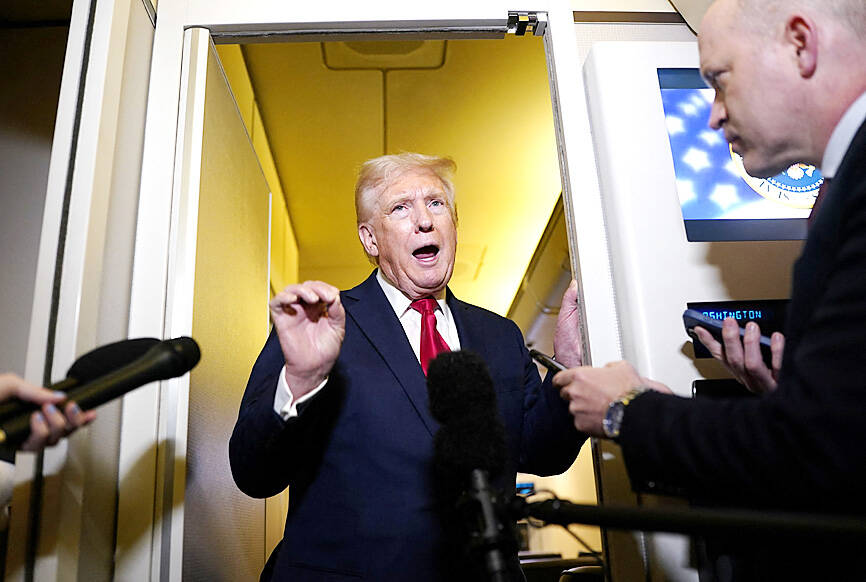Markets yesterday welcomed a US tariffs reprieve for electronics, but US President Donald Trump warned no country would get “off the hook” in his trade war — especially China, while pledging to impose tariffs on semiconductors in the “not distant future.”
While the US on Friday listed tariff exemptions for smartphones, laptops, semiconductors and other electronic products for which China is a major source, Trump and some of his top aides said on Sunday that the exemptions had been misconstrued and would only be temporary as his team pursued fresh tariffs against many items on the list.
“NOBODY is getting ‘off the hook’ ... especially not China which, by far, treats us the worst,” Trump posted on his Truth Social platform.

Photo: Reuters
Chinese President Xi Jinping (習近平) yesterday said that protectionism “will lead nowhere” and a trade war would “produce no winner.”
Shares in Taiwan yesterday closed slightly lower, with initial gains eroded as lingering concerns over the Trump administration’s tariffs on semiconductors continued to hurt market sentiment.
The TAIEX closed down 15.68 points, or 0.08 percent, at 19,513.09, while Taiwan Semiconductor Manufacturing Co (TSMC, 台積電), the most heavily weighted stock on the local market, lost 2.7 percent.
“Investors simply took the money and ran after trimming their holdings in TSMC as the TAIEX rebounded today,” Cathay Futures Consultant Co (國泰證期) analyst Tsai Ming-han (蔡明翰) said. “They fear Trump’s tariffs on semiconductors will bomb the market.”
Other Asian and European stock markets yesterday rallied over the news of Washington’s new exemptions. The Paris, Frankfurt and London stock exchanges were up about 2 percent in morning deals, while Tokyo finished 1.2 percent higher, Seoul gained 1 percent and Hong Kong jumped 2.3 percent.
Shanghai picked up 0.8 percent after the latest data showed that China’s exports last month surged 12.4 percent from a year earlier.
However, the relief could be short-lived, with some of the exempted consumer electronics targeted for upcoming sector-specific tariffs on goods deemed key to US national defense networks.
On Air Force One on Sunday, Trump told reporters that tariffs on semiconductors “will be in place in the not distant future.”
“Like we did with steel, like we did with automobiles, like we did with aluminum ... we’ll be doing that with semiconductors, with chips and numerous other things,” he said.
“We want to make our chips and semiconductors and other things in our country,” Trump reiterated, adding that he would do the same with “drugs and pharmaceuticals.”
The US president said he would announce tariffs rates for semiconductors “over the next week,” while US Secretary of Commerce Howard Lutnick said they would likely be in place “in a month or two.”
The White House insists the aggressive policy is bearing fruit, saying dozens of countries have already opened trade negotiations to secure deals before the 90-day pause ends.
“We’re working around the clock, day and night, sharing paper, receiving offers and giving feedback to these countries,” US Trade Representative Jamieson Greer told CBS’ Face the Nation on Sunday.
Additional reporting by CNA with staff writer

Taiwan Semiconductor Manufacturing Co (TSMC, 台積電) last week recorded an increase in the number of shareholders to the highest in almost eight months, despite its share price falling 3.38 percent from the previous week, Taiwan Stock Exchange data released on Saturday showed. As of Friday, TSMC had 1.88 million shareholders, the most since the week of April 25 and an increase of 31,870 from the previous week, the data showed. The number of shareholders jumped despite a drop of NT$50 (US$1.59), or 3.38 percent, in TSMC’s share price from a week earlier to NT$1,430, as investors took profits from their earlier gains

In a high-security Shenzhen laboratory, Chinese scientists have built what Washington has spent years trying to prevent: a prototype of a machine capable of producing the cutting-edge semiconductor chips that power artificial intelligence (AI), smartphones and weapons central to Western military dominance, Reuters has learned. Completed early this year and undergoing testing, the prototype fills nearly an entire factory floor. It was built by a team of former engineers from Dutch semiconductor giant ASML who reverse-engineered the company’s extreme ultraviolet lithography (EUV) machines, according to two people with knowledge of the project. EUV machines sit at the heart of a technological Cold

TAIWAN VALUE CHAIN: Foxtron is to fully own Luxgen following the transaction and it plans to launch a new electric model, the Foxtron Bria, in Taiwan next year Yulon Motor Co (裕隆汽車) yesterday said that its board of directors approved the disposal of its electric vehicle (EV) unit, Luxgen Motor Co (納智捷汽車), to Foxtron Vehicle Technologies Co (鴻華先進) for NT$787.6 million (US$24.98 million). Foxtron, a half-half joint venture between Yulon affiliate Hua-Chuang Automobile Information Technical Center Co (華創車電) and Hon Hai Precision Industry Co (鴻海精密), expects to wrap up the deal in the first quarter of next year. Foxtron would fully own Luxgen following the transaction, including five car distributing companies, outlets and all employees. The deal is subject to the approval of the Fair Trade Commission, Foxtron said. “Foxtron will be

INFLATION CONSIDERATION: The BOJ governor said that it would ‘keep making appropriate decisions’ and would adjust depending on the economy and prices The Bank of Japan (BOJ) yesterday raised its benchmark interest rate to the highest in 30 years and said more increases are in the pipeline if conditions allow, in a sign of growing conviction that it can attain the stable inflation target it has pursued for more than a decade. Bank of Japan Governor Kazuo Ueda’s policy board increased the rate by 0.2 percentage points to 0.75 percent, in a unanimous decision, the bank said in a statement. The central bank cited the rising likelihood of its economic outlook being realized. The rate change was expected by all 50 economists surveyed by Bloomberg. The